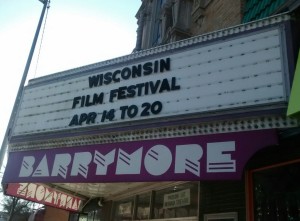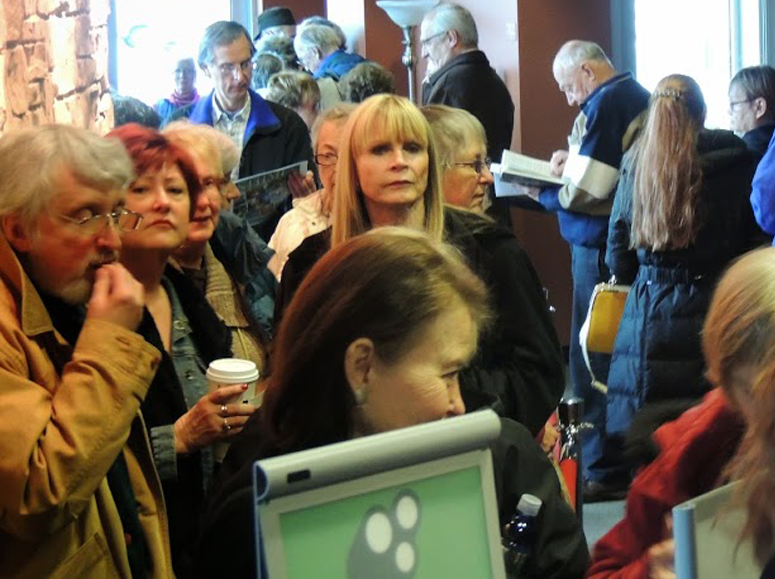
Discuss: Wisconsin Film Festival Venues and Box Office
East and West, Will the Twain Meet at the 2016 Wisconsin Film Festival?
Sean Weitner returns with another entry in his ongoing coverage of the logistics and box office of the Wisconsin Film Festival. For additional contextual information, see his 2014 post-Festival contribution to the Madison Film Forum.
The 2016 Wisconsin Film Festival begins this week, and like most years, the composition of the festival—in terms of its venues, days, and number of screenings—is unique. What can we say about this year’s festival by looking at the performance of previous festivals, particularly 2015?
Starting in 2012, the Festival has had four years of ticket sales bouncing between 26,000 and 29,000. Sales had peaked in 2011 with 36,000 tickets sold. That year also was the last festival confined to the isthmus: two Memorial Union venues, two campus venues, two State St. venues, and two capitol square venues. Sundance Cinemas Madison became a festival venue in 2012, and from 2013 onward it became the anchor, with the majority of the Festival’s events held there.
Many things happened between the 2011 and 2012 Festivals, including changes in administration, but perhaps most significant is that the Festival’s two biggest venues, the Orpheum and the Wisconsin Union Theater, began undergoing renovations. In the wake of those closures, it was possible to imagine that the Festival’s incorporation of Sundance was a stopgap measure via which the Festival could maintain its momentum, however reduced it may be, while the big houses stitched themselves back together.
By the time of the 2013 Festival, however, it was clear that the event’s DNA had changed. The Festival, which took a decade to expand to a five-day Wednesday-to-Sunday run, now became an eight-day affair as the program aligned itself to Sundance’s practice of booking its theaters for a solid week. Multiple attendees at the time told me this put them off because they valued the endurance race of exhausting oneself over the course of one protracted weekend, but that this new duration went from stretching them to snapping them.
Equally significant was the Festival no longer had a downtown core, changing from having six theaters east of Park St. in 2012 to only three in 2013. The Festival was no longer a walkable event, apart from walking between Sundance’s three screens.
In 2016, the Festival’s farthest flung venues, Sundance and the Barrymore, are six miles apart—a 17-minute drive before you add parking time on each side. Rather than Great Taste of the Midwest, a festival that prizes bringing the masses to one nerve center, this configuration reminds me more of Restaurant Week, a citywide gala in which many independent organizations participate. (Although presumably you don’t hurry to finish a meal at Sardine because you have a reservation at Smoky’s in 20 minutes.)
While the Festival has metamorphosed, ticket buyers have been willing—give or take that 10,000-ticket drop—to transform with it. In 2015, the Festival reported sales of 26,500 tickets. That sales figure is roughly the same number sold at the 2006 and 2013 festivals, and about a 6.5 percent drop from 2014’s bump to 28,300. But these numbers are stable and apparently sustainable; Festival coordinator Ben Reiser said 2014 attendance “exceeded our expectations,” which suggests that the Festival has determined it can survive by expecting sales in this 26,000 range it consistently draws.
 In terms of screens, the 2016 Festival is very similar to the 2015 Festival, which itself had an almost identical composition to 2014. In 2015, the Festival substituted the marginally smaller Madison Museum of Contemporary Art for the Elvehjem. Looking forward to 2016, the only switch-up is dropping the Capitol Theater, which seats 1,100, in favor of the Barrymore, a venue for whose shows Reiser is “trying not to sell more than 700 tickets,” but allows that they may push on that number for hot tickets like The Smart Studios Story. “It’s still not entirely clear to me how many seats we might actually be able to get in there,” Reiser said. All other venues have between 150 and 330 seats. In a story published and then updated after our conversation with Reiser, Isthmus reports that the Barrymore capacity will be 800 seats.
In terms of screens, the 2016 Festival is very similar to the 2015 Festival, which itself had an almost identical composition to 2014. In 2015, the Festival substituted the marginally smaller Madison Museum of Contemporary Art for the Elvehjem. Looking forward to 2016, the only switch-up is dropping the Capitol Theater, which seats 1,100, in favor of the Barrymore, a venue for whose shows Reiser is “trying not to sell more than 700 tickets,” but allows that they may push on that number for hot tickets like The Smart Studios Story. “It’s still not entirely clear to me how many seats we might actually be able to get in there,” Reiser said. All other venues have between 150 and 330 seats. In a story published and then updated after our conversation with Reiser, Isthmus reports that the Barrymore capacity will be 800 seats.
At the 2015 festival, there were 166 separately ticketed events across eight venues, for a total capacity of 47,400 seats (which, granted, excludes complimentary seats for guests and press). This compares to 161 events in 2014, and 171 events in 2016. If the Barrymore is being measured against an 800-seat yardstick, then there will be more tickets for sale in 2016 than there were in 2015.
The 2015 Festival’s 26,500 tickets means that they only sold 56 percent of all seats available. By comparison, they sold 68 percent of all seats in 2014. Instinctively that sounds dire, but in 2015 the Festival featured three days of shows in the enormous Capitol Theater, versus only one day in 2014. That had deflating effect on the average.
In 2014, the Festival provided Capitol-specific sales figures, and when tickets for that hardest-to-fill hall were removed from the equation, the 2014 sell-through rate rose to 72 percent.
It’s unclear whether the sale of Sundance Cinema’s parent company to AMC might mean big changes for 2017. Sundance profits greatly from hosting the Festival—apart from the theater rental fee, the exponentially greater foot traffic relative to an average weekend, much less weekday, means they’re making a killing on concessions alone—and so it’s unlikely that its new Fortune 1000 parents will dismiss a municipal festival out of hand.
Apart from total 2016 sales, my big questions once this year’s numbers have been crunched will be as follows:
- The Capital Times reports that the Festival sold an estimated 20,000 tickets the weekend tickets went on sale. Assuming 2016 sales resemble the past four years, that’s about 75 percent of all tickets sold. How has that percentage changed over the history of the Festival? Likewise, what percentage of tickets were sold at the door, and how has that changed?
- How many tickets per buyer? Are ticket prices and travel times affecting the number of films die-hards try to see?
- Will the good vibes in the Barrymore Theater neighborhood reported in Isthmus translate into ticket sales, and a willingness to hop to campus and Hilldale beyond the Barrymore’s screenings?
- Are students buying multiple $8 tickets and finding their way to venues? How do student sales compare to attendance at last week’s 3-day, 16-film, 1-location, student programmed, and free WUD Film Marquee International Film Festival at Union South?
- If the model really has moved from Great Taste to Restaurant Week, what would make a venue like Market Square (3.3 miles from Sundance, and an 8 minute drive) a good or bad prospect? (This is a just a f’rinstance—although they do still have 35mm projectors.)
- In 2014, Reiser said that the Festival had requested a 2016 berth at the Wisconsin Union Theater. For whatever reason, that didn’t happen—does the Festival expect to be able to come to terms in the future?
- Is the Capitol Theater space too big for the Wisconsin Film Festival if State Street is no longer the hub? Is the Overture satisfied limiting its participation in Madison’s film culture to Duck Soup Cinema, which is curiously counter-programming Buster Keaton’s The Cameraman during the Festival weekend?